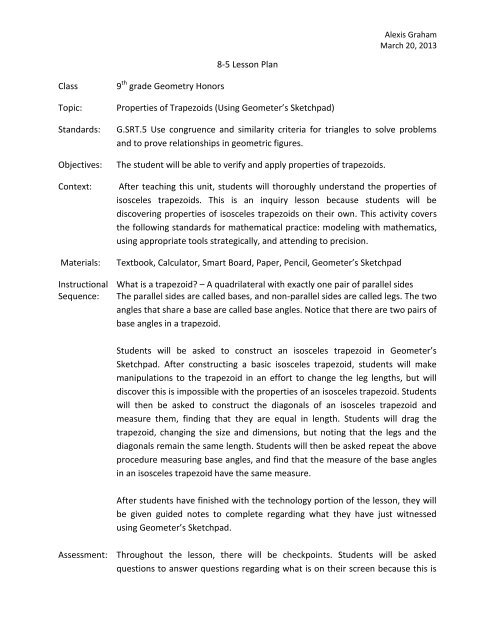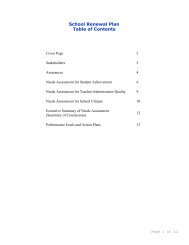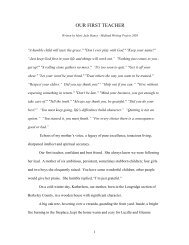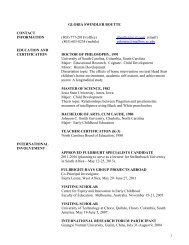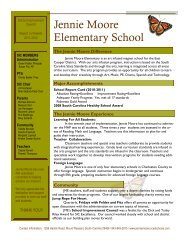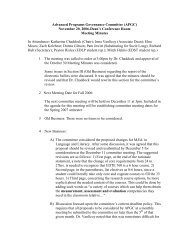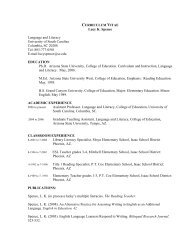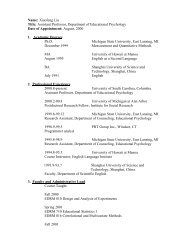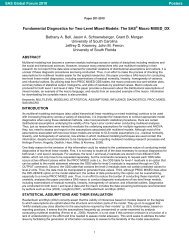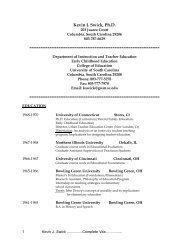8-5 Lesson Plan Class 9th grade Geometry Honors Topic ...
8-5 Lesson Plan Class 9th grade Geometry Honors Topic ...
8-5 Lesson Plan Class 9th grade Geometry Honors Topic ...
You also want an ePaper? Increase the reach of your titles
YUMPU automatically turns print PDFs into web optimized ePapers that Google loves.
<strong>Class</strong> 9 th <strong>grade</strong> <strong>Geometry</strong> <strong>Honors</strong><br />
8-5 <strong>Lesson</strong> <strong>Plan</strong><br />
<strong>Topic</strong>: Properties of Trapezoids (Using Geometer’s Sketchpad)<br />
Alexis Graham<br />
March 20, 2013<br />
Standards: G.SRT.5 Use congruence and similarity criteria for triangles to solve problems<br />
and to prove relationships in geometric figures.<br />
Objectives: The student will be able to verify and apply properties of trapezoids.<br />
Context: After teaching this unit, students will thoroughly understand the properties of<br />
isosceles trapezoids. This is an inquiry lesson because students will be<br />
discovering properties of isosceles trapezoids on their own. This activity covers<br />
the following standards for mathematical practice: modeling with mathematics,<br />
using appropriate tools strategically, and attending to precision.<br />
Materials: Textbook, Calculator, Smart Board, Paper, Pencil, Geometer’s Sketchpad<br />
Instructional What is a trapezoid? – A quadrilateral with exactly one pair of parallel sides<br />
Sequence: The parallel sides are called bases, and non-parallel sides are called legs. The two<br />
angles that share a base are called base angles. Notice that there are two pairs of<br />
base angles in a trapezoid.<br />
Students will be asked to construct an isosceles trapezoid in Geometer’s<br />
Sketchpad. After constructing a basic isosceles trapezoid, students will make<br />
manipulations to the trapezoid in an effort to change the leg lengths, but will<br />
discover this is impossible with the properties of an isosceles trapezoid. Students<br />
will then be asked to construct the diagonals of an isosceles trapezoid and<br />
measure them, finding that they are equal in length. Students will drag the<br />
trapezoid, changing the size and dimensions, but noting that the legs and the<br />
diagonals remain the same length. Students will then be asked repeat the above<br />
procedure measuring base angles, and find that the measure of the base angles<br />
in an isosceles trapezoid have the same measure.<br />
After students have finished with the technology portion of the lesson, they will<br />
be given guided notes to complete regarding what they have just witnessed<br />
using Geometer’s Sketchpad.<br />
Assessment: Throughout the lesson, there will be checkpoints. Students will be asked<br />
questions to answer questions regarding what is on their screen because this is
Alexis Graham<br />
March 20, 2013<br />
an individual assignment. After each construction students are also supposed to<br />
check with the teacher, and write a conjecture about their measurements since<br />
notes are only given afterward the technology portion of the lesson. At the<br />
beginning of the next class, students will have an admit slip with applied<br />
questions regarding properties of trapezoids.<br />
References: Bennett, Dan. Exploring <strong>Geometry</strong> with The Geometer's Sketchpad. Emeryville,<br />
CA: Key Curriculum, 2002. Print.


